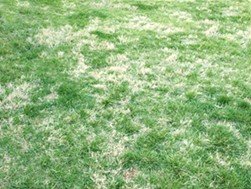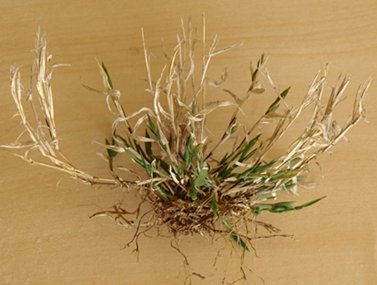Nimblewill Lawn Weed Identification
and Control Methods
Nimblewill is a wiry, upright growing perennial grass and is considered an invasive weed that invades lawns, flowerbeds, and gardens. It resembles creeping bentgrass and bermudagrass in parts of its structure and appearance.
However, it lacks the long runners of bermudagrass. It really stands out in cool season grasses, especially when dormant when the grass is tan colored.
In summer, nimblewill is a lighter shade of green than most cool season grasses and has a very different blade texture, so again, it easily stands out.
Nimblewill is a warm season, stoloniferous, perennial grass.
Once established, it will green up as soil temperatures warm in mid-spring. It greens up about the same time or shortly after other warm season grasses, but long after cool season grasses begin to grow. Although it resembles some turfgrass species, it doesn’t form extremely thick clumps required for a nice turf and its color is a light green.
In the fall, it will turn a light tan color as it begins to go dormant. In the photo taken in early spring, dormant nimblewill is easily spotted in a fescue lawn where the contrast is clearly visible.
Spread of Nimblewill
This plants grows in clumps that most often start from seed. Each plant can produce thousands of tiny seed that can remain dormant until conditions are suitable for germination. Like other warm season grass plants, germination occurs in late spring as soil temperatures warm to 70 degrees.
It produces short stolons that grow horizontally on the surface of the soil. These stolons can produce new plants at the nodes.
"Nodes" are swollen areas of the stolon containing special cells designed to produce new plants identical to the mother plant.
In other words, it is the growing points along the stolon.
The photo above shows a single plant with upright growing stems. While the center of the plant grows upright, the outer stems often grow horizontally before bending upright. Where the horizontal stems touch the ground, any node can root and start another plant. In summer the entire plant will be green with stalks of finger like seed heads.
Mowing can also help spread this invasive perennial grass. The seeds discharged by the mower can start new plants where ever there is enough sunlight and warmth. In this way, the weed can spread quickly beyond its original starting point. Bagging the grass can help, but is not a cure.
How to Kill Nimblewill
"Tenacity Herbicide" Kills Nimblewill, but Not Your Grass
There is now a selective herbicide that will control nimblewill in turfgrass. The herbicide's trade name is "Tenacity" produced by Syngenta. It has a "caution" label.
Tenacity can control over 40 types of grassy and broadleaf weeds in turf and can be used on newly established grass as well as older turf. There may be some "whitening of the grass blades" on some turf grasses, such as fescue, but it is temporary and will grow out.
Use Tenacity when the grass is green and growing. It may take about 10 days to begin to see results, but the nimblewill will soon die after that. Use only in accordance with the label. Do not spray when the target weed is dormant. You may see very little or no effect next spring.
It can be safely used on the following grass without harm, when used as directed:
- Kentucky Bluegrass
- Perennial Ryegrass
- Most Fine Fescues
- Centipedegrass
- Buffalograss
- St. Augustinegrass, but only on sod farms
It cannot be used on the following turfgrass:
- Bentgrass
- Annual Bluegrass
- Bermudagrass
- Kikuyugrass
- Seashore Paspalum
- Zoysiagrass
Tenacity can be purchased online or may be found at some home and garden stores. It comes in an 8oz bottle and uses 1 teaspoon per gallon. However, read and follow the label directions carefully.
Non-Selective Herbicides such as "Round-Up"
You can also use a non-selective herbicide, such as Round-Up and similar products. These are also called "All Vegetation Killer" and will kill all the grass and weeds it touches. The most common active ingredient in home and commercial non-selective herbicides is glyphosate, the active ingredient of Round-Up. Broadleaf weed herbicides do not have any affect on nimblewill.
Spot spraying Round-UP is the best choice to reduce as much damage to good grass as possible. You will most likely need to reseed after all the plants have completely died. Follow good overseeding practices for best results. Click here to view our page on Overseeding Lawns.
Organic methods of Control
If you prefer more organic methods of killing Nimblewill, try agricultural vinegar. It is stronger than household vinegar and can burn your hands, so wear gloves. It will work by burning the above ground portions of the plant. It should be enough to kill it, but you will have to make sure all of the nimblewill is sprayed.
Other Weed Control Considerations
If your neighbors have nimblewill, but you do not yet, it is important to use a preemergent herbicide each spring. The preemergent is most often added to spring fertilizers and are labeled as crabgrass preventer, etc.
Commercial preemergents are generally stronger than homeowner versions and some commercial brands last all season. The homeowner varieties often last only four months and may need a second application by mid-summer. Keep in mind that frequent heavy rains stress preemergents, shorten their lifespan, and decrease their ability to stop weed seed germination.
If you have a cool season grass, you may be able to limit the growth and spread of nimblewill by over-seeding each year in the fall. A thick, vibrant lawn is a strong deterrent for most weeds and may greatly hinder growth of nimblewill as well. A well maintained and thick lawn, accompanied by frequent mowing, is the best defense against many invasive weeds and cuts down on herbicide use as well.
For warm season grasses, maintaining a thick, healthy lawn, such as bermudagrass, zoysia, and others will generally choke out many weeds and keep them from advancing. Follow good maintenance, mowing, and fertilization practices for your specific grass type.
Proper Techniques to Overseeding Lawns
Overseeding lawns is one of the most overlooked practices by homeowners. However, it is one of the most important steps you can take to maintain a consistently thick and beautiful lawn. Find complete information on why and how to overseed correctly.
All About Lawn Weeds
Lawn weeds are the most common problem facing home lawns. Find out what they are, look at lawn weed identification pictures, and how to control them.
Using Herbicides Safely
Herbicides are very useful in controlling weeds, but if misused they can be dangerous.
Poison Ivy Plant Identification and Fact Sheet
Poison ivy causes severe rashes, itching, and blisters. The best way to avoid this toxic plant is to be able to instantly identify it. Find help on identification and well as other important information.
Kudzu Plant Information and Control
Kudzu is an fast growing and aggressive plant that covers everything in its path. Nothing of off limits as it covers fields, fences, trees, and even whole houses. Find out its uses, as well as, how to stop this vine.
Noxious Weed Identification and Control
Noxious weeds are defined as plants that harm agricultural lands, pose harm to humans, resist chemical controls, clog waterways and ponds, displace native plants, and alter soil composition.
Nimblewill Grassy Weed to Lawn Care Academy Home





